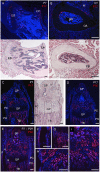Primary cilia are necessary for Prx1-expressing cells to contribute to postnatal skeletogenesis
- PMID: 30002136
- PMCID: PMC6127732
- DOI: 10.1242/jcs.217828
Primary cilia are necessary for Prx1-expressing cells to contribute to postnatal skeletogenesis
Abstract
Although Prx1 (also known as PRRX1)-expressing cells and their primary cilia are critical for embryonic development, they have yet to be studied in the context of postnatal skeletogenesis owing to the lethality of mouse models. A tamoxifen-inducible Prx1 model has been developed, and we determined that expression directed by this promoter is highly restricted to the cambium layers in the periosteum and perichondrium after birth. To determine the postnatal role of these cambium layer osteochondroprogenitors (CLOPs) and their primary cilia, we developed models to track the fate of CLOPs (Prx1CreER-GFP;Rosa26tdTomato) and selectively disrupt their cilia (Prx1CreER-GFP;Ift88fl/fl). Our tracking studies revealed that CLOPs populate cortical and trabecular bone, the growth plate and secondary ossification centers during the normal program of postnatal skeletogenesis. Furthermore, animals lacking CLOP cilia exhibit stunted limb growth due to disruptions in endochondral and intramembranous ossification. Histological examination indicates that growth is stunted due to limited differentiation, proliferation and/or abnormal hypertrophic differentiation in the growth plate. Collectively, our results suggest that CLOPs are programmed to rapidly populate distant tissues and produce bone via a primary cilium-mediated mechanism in the postnatal skeleton.
Keywords: Growth plate; Osteochondroprogenitors; Periosteum; Postnatal skeletogenesis; Primary cilia; Prx1.
© 2018. Published by The Company of Biologists Ltd.
Conflict of interest statement
Competing interestsThe authors declare no competing or financial interests.
Figures








References
-
- Alvarez J., Sohn P., Zeng X., Doetschman T., Robbins D. J. and Serra R. (2002). TGFbeta2 mediates the effects of hedgehog on hypertrophic differentiation and PTHrP expression. Development 129, 1913-1924. - PubMed
Publication types
MeSH terms
Substances
Grants and funding
LinkOut - more resources
Full Text Sources
Other Literature Sources
Medical
Molecular Biology Databases

